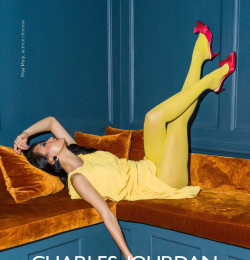

Charles Jourdan
About
founded by
Charles Jourdan
belongs to
Groupe Royer
about
Charles Jourdan was born in 1883 in France. Originally trained as a shoemaker, after World War I Jourdan opened a shoe shop in Romans in the Drome region of France, the center of France's shoe industry. His lines of women's shoes prospered, and this became the focus of his career. After only two years Jourdan moved his shoe company into a factory on Boulevard Voltaire in 1921 and employed over 30 people in Romans.
In the 1930's, Charles Jourdan was the first shoe designer to advertise in fashion magazines.
After World War II, Jourdan was joined by his 3 sons Rene, Charles and Roland and in 1957, they opened a boutique in Paris and began selling designer shoes in the United Kingdom.
The youngest son, Roland Jourdan, who was responsible for design and development, has been described as "the most able man in the shoe industry." He was fully aware that it was simplicity and quality, not wild innovation, that sold Jourdan shoes. When Jourdan's first boutique opened in Paris in 1957, Roland Jourdan only offered a small range of styles. But each style was available in 20 colors, all sizes, and three widths. At Jourdan, not only would the shoe fit, but it would also perfectly accessorize any shade of outfit.
They were granted a license to design and manufacture shoes under the Christian Dior brand in 1959 and in more recent years have also created designs under the Pierre Cardin label.
The company has for many years focused on being viewed as setting trends and innovating in fashion design, and it can be debated whether Herbert Levine and Beth Levine inspired this innovation or learned from it; both may be true. Jourdan and the Levines are arguably the most innovative designers to use new materials in women's shoes in the period since World War II.
Jourdan's designs are up-to-the-minute. In the 60's and early 70's, the firm created an avant-garde image for itself by using the surrealist photographer Guy Bourdin for its advertising campaign.
During this period the company sold vast quantities of two notable Styles, the 'Madly' a thick-heeled platform shoe with a high vamp, in red or black patent leather, and the 'Maxime' a low-heeled square-toed court shoe with a satin bow.
In 1975 ready-to-wear clothing and handbags were added to the Jourdan line, although the company has remained best-known for its shoes.
Charles Jourdan died in 1976, but his sons continued the firm. Building on his father's tailored style, Roland Jourdan took the basic pump shape, elongated the toe and saddled it with the simplest of buckles. By this time Jourdan boutiques were open in major cities across Europe and in North America. Roland Jourdan retired in 1981, and the company subsequently was known for more conservative designs.
Jourdan gained unintended publicity from the exposure of Imelda Marcos' excesses in shoe fashion in 1986, among them many Jourdan stilettos.
During the 80's and 90's, they have been associated with a more conservative look although sometimes they create a powerful design like this boot with embroidered suede from 1988.
In 1996, to celebrate the 75th anniversary of the house of Charles Jourdan, they brought out a perfume named "Stiletto" in a bottle shaped like the Eiffel Tower.
In the 1990s, newer and younger lines were introduced yet still evincing the sleek, elegant style for which the Jourdan name is famous. The company went online with the Charles Jourdan website in 1997, one of the earliest couture houses to do so, and opened new boutiques in Australia, France, Germany, Israel, the Middle East, Russia, and the U.S. over the next two years. In 1999, the company redesigned its image and brand, creating an updated "visual identity" befitting the coming millennium. Charles Jourdan remains an important name in the fashion world, because its enduring strength is the recognition that what any man or woman really wants in shoewear or clothing, is the simply the perfect fit.
The flagship store for the Romans-based manufacturer was moved to the Champs-Elysees in Paris in 1999, but it remained open for less than two years due to financial troubles caused by a switch in emphasis from design to retailing. In mid 2002 the company filed for bankruptcy with over $9 million in debt and was reorganized as the Jourdan family sold its stake to a Luxembourg investment fund, Lux Diversity. Sales had fallen to only 65,000 pairs per year.
Patrick Cox is a Canadian-born shoemaker with his own very successful label. He has been tapped as the designer of Charles Jourdan in 2003. Since he spent his childhood in West Africa, he speaks fluent French so fits in well with the great French shoe house. He has immersed himself in the Charles Jourdan archives and is confident of making contemporary shoes as successful as in the past.
In February 2005 the house appointed Josephus Thimister as designer to replace Patrick Cox, who was leaving.
For a while new shoes haven't been produced in some time, but in October 2009 the label returned back at Paris Fashion Week at the Premiere Classe exhibition.
Alexandra Neel who used to work with Balenciaga and Celine is creating the new collection for the label’s owners Groupe Royer, who purchased the company in December 2008.
Perfumes
Official Social Media
Latest Charles Jourdan Advertisements
